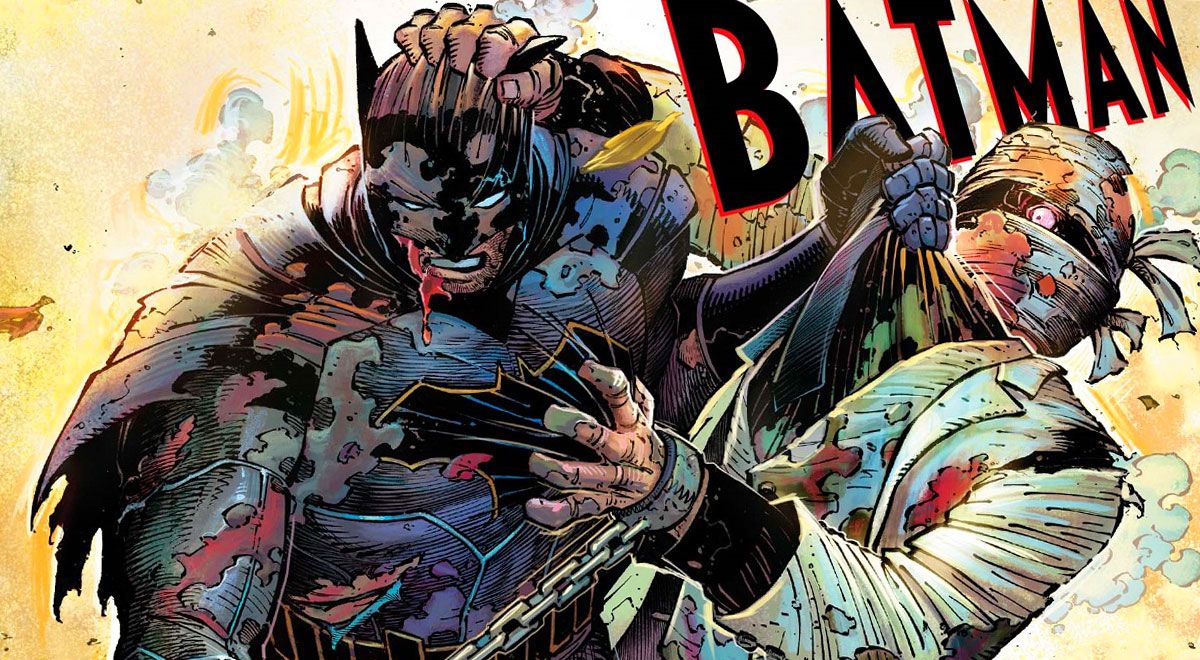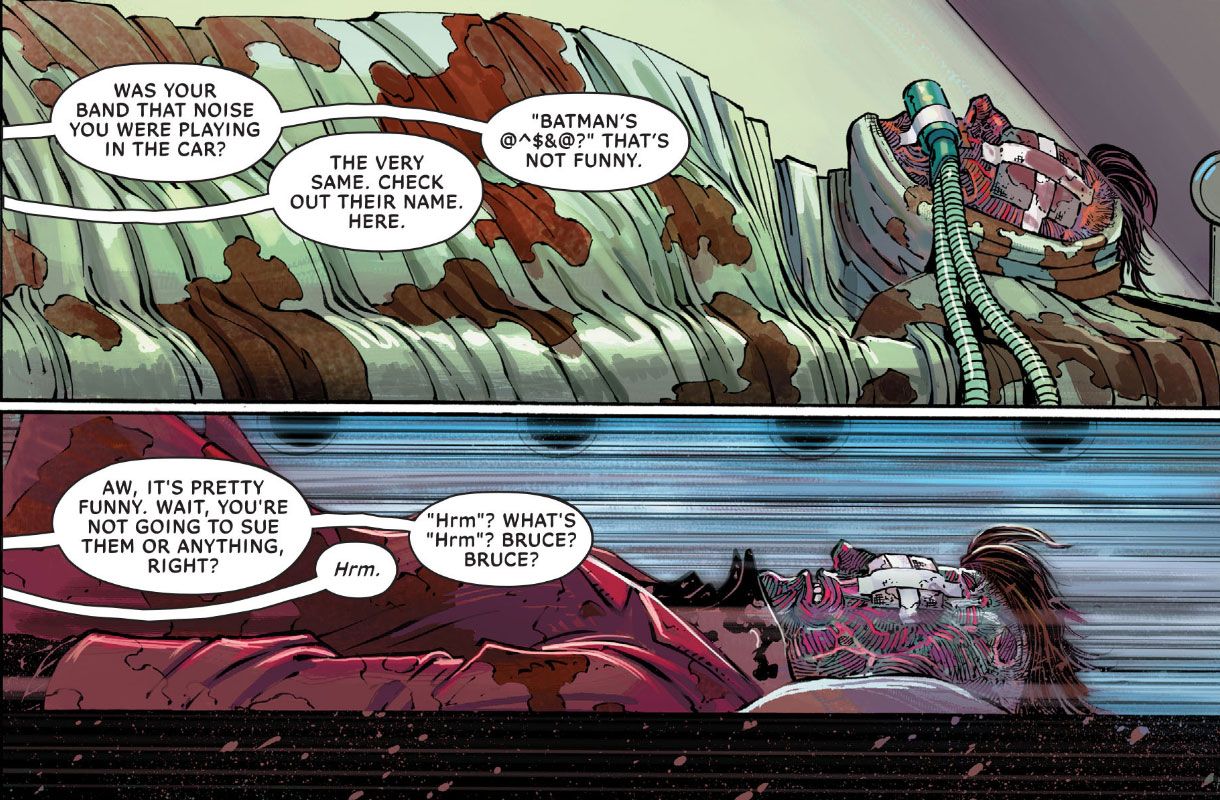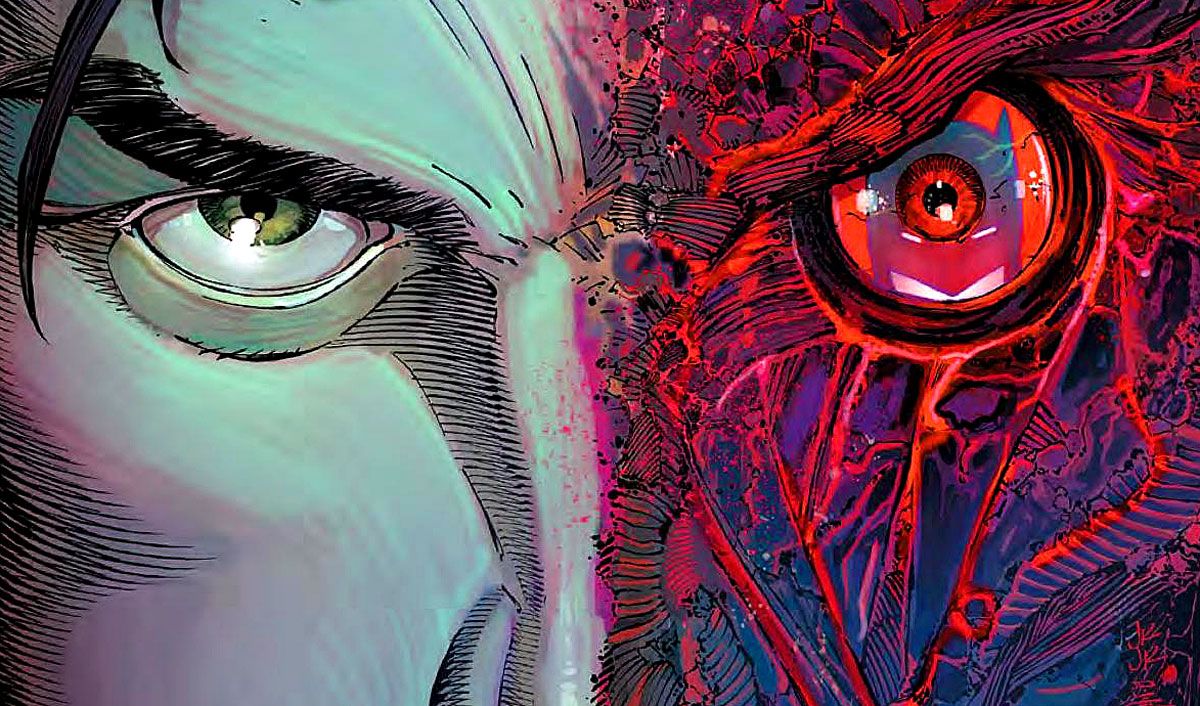It's not like "Batman" ever was in danger of fading into oblivion, but for five years from 2011 to 2016, writer Scott Snyder and artist Greg Capullo revitalized the series, adding new concepts to the Bat-mythos like the Court of Owls, and exploring classic villains like the Joker. After their run wrapped earlier this year, Capullo turned his focus to a Mark Millar-written creator-owned series, and Snyder readied his DC Comics work -- a new Batman series with rotating artists and shaped by his unique vision, titled "All-Star Batman."
The first artist on the series is John Romita Jr., who's drawn just about every major Marvel character in his storied career, but is still relatively new to the DC scene. Snyder and Romita have teamed up (along with a back-up feature drawn by Declan Shalvey) for "All-Star Batman," specifically the five-issue Two-Face story that sees the creators taking on Harvey Dent and his villainous alter ego for the first time. Both Snyder and Romita see "All-Star Batman" as something different for their careers, especially since it's not set in a "dark, dingy back alley."
RELATED: Batman’s Pre-Flashpoint Ally [SPOILER] Returns in All-Star Batman #3
CBR spoke with Snyder and Romita earlier this month at New York Comic Con about their artistic partnership, exploring Two-Face as a villain for complicated modern times, and constructing a story that's a little more lighthearted than the bulk of Snyder's oft-serious "Batman" run.
CBR News: Scott, you've talked a lot over the years about your close relationships with your artistic collaborators. John, you've worked with so many different writers in your career; some of the biggest names in the industry. You've now worked together for a few months, there are a few issues of "All-Star Batman" out there -- what has this collaboration been like for both of you?
John Romita Jr.: Every time you work with a new writer, it's a different experience, and you change what you produce because of the difference in writers. But when a writer challenges you, and I don't mean in an annoying way, when they come up with something literally you haven't done before... You can ask my wife this, because I say it over and over. I want to do something I haven't done before. Not necessarily from the writer; I have to come up with something different. I've done a million close-ups and a million different panels the same way. To try to do something different every single time, while I can't succeed, I try.
To get a writer like Scott that comes up with a premise that's out of left field with Batman -- everybody assumes Batman's in a dark, dingy back alley. This is out of left field, and it's so good. This is a challenge. I don't get to hide behind any shadows, except for a couple scenes inside of a tunnel.
Scott Snyder: Yeah, there's a couple. [Laughs]
Romita: But it's such a good premise. It's a road thing -- imagine Batman dragging Two-Face down a long, dusty road in the middle of nowhere. I love that! Gigantic scenes! It's a complete departure, and because of that, it allows me to do things I've never done before. I was on the top of a trestle over a deep ravine with a river at the bottom. I haven't done that before! It was outstanding.
Which has to feel good.
Romita: Absolutely. I want to do something different -- boom, Scott comes along.
Snyder: That's how it feels for me too, man. I did Batman for five years, and "Detective" before that. I tried hard with every arc to do something that Greg [Capullo] and I hadn't done before. With "All-Star," the challenge was to totally reinvent myself and reinvent the character for me and feel young on the book. When we met for the first time and talked about it -- we live in the same town, we met for beers downtown in our little port town -- he was like, "What do you want to do? What kind of Batman stuff?" I was very clear: Here's the story, here's the thing I'm thinking, but, all I care about is that you go to work feeling like it's some of your best stuff, with a renewed sense of energy and excitement. I want that, too.
I think it shows on the page for me, too, how much fun I have with it, how different it is, all of it. It's an incredible collaboration. I was literally just talking to him minutes ago about, "When can we work together again? What can we do next?" It's been a joy. Honestly, he makes me up my game all the time. As much as I was like, "I'm going to challenge you to draw Batman in a way we haven't seen before, his art comes back, and the storytelling is so superlative, it challenges me to find ways of upping my game even with little jokes and things. I've got to earn my keep on this thing, because the storytelling's good without me! [Laughs] Or I can just say nothing and it would probably be better. But ultimately I was like, "I'll throw in a joke."
Even in the last issue, I threw in a joke about Duke [Thomas] listening to a band called "Batman's something," and it's censored. It's like a metal band. Batman's like, "What's the name of that band?" And he's like, "Batman's [bleep]." And he's like, "That's not funny." [Duke's] like, "Come on, it's a bunch of Arkham inmates that reformed and now are in a band. It's a little funny, come on, Bruce. Wait, you aren't going to sue them, are you, Bruce?" And Bruce is just like, "Hrm." "What does Hrm mean?"
I look at the art and he tells the story so well that it frees me up not to have to repeat anything through captions or dialogue, because you get what's going on. I can do something in dialogue or captions that adds to it in a way that doesn't have to do with explanatory storytelling. It just does character work, because the whole story is told visually so well already. It's a joy, honestly. He's one of those guys, like Greg, like Sean [Murphy], that I want to cultivate a relationship with, to work with, over and over again as long as we can. It's a joy and a real inspiration.
This arc focuses on Batman and Two-Face, who is a character you didn't use in your "Batman" run, Scott, and a character you haven't really drawn before, John, given that you were at Marvel for so many years. It's a classic villain, one with such inherent pathos -- for both of you, in doing this five-part story starring Two-Face, what have you learned about the character and how have you enjoyed digging into what makes him tick?
Romita: Another instance where I had never considered that I would be doing Two-Face, ever. Hearing the premise, and the total scope of this plan, makes the character so much better. The story makes Two-Face better.
Then he said, "We can play with the way he looks. You can't go too far." So I kind of combined all the reference, and we set the way his face looks. What's funny is, I did a close-up cover of his face ["All-Star Batman" #2], and that imprint of the scarring, I have to follow. So I have my own cover up on my desk, [as] reference.
Snyder: And you're cursing yourself?
Romita: Yes! "Why did I do this to myself?" But at least it's consistent. Then he gets hit by a couple of things, and there's more scarring on his face that has to be different. The eye is so important to the story. So many things about the character I never would have assumed, that he brought out. Without the art, they were great. It makes the story great. I have to keep up with stuff like that. I'm excited, because I covered a character that I never thought I would ever do.
Snyder: I wanted to do Two-Face for two reasons. One was personal. I had a bit of a rough year the year before I came up with the arc. We had somebody in our family who had struggled for a long time with addiction, on my wife's side, and passed away; never really overcame those things. I have trouble sometimes with anxiety and depression. I went through a period where, when I don't feel well, I feel like you're somebody you don't like when you look in the mirror. You're the collection of your flaws. Two-Face was the character that really spoke to me that way, and was the guy saying, "Yeah, that's right. You're just the monstrous side of yourself you don't want to show anybody. All of the bad thoughts you have. All of that."
Secondarily, the thing I thought was interesting was this moment in time -- not just politically, but all across the globe, as corny as that sounds. Certainly nationally, but there's this sense, regardless of your political leanings that we're all facing these really big, insurmountable challenges. Everything from huge problems like the Syrian refugee crisis, to things in this country, like institutionalized racism. All of the stuff that we talk about all of the time that no [single] one of us is going to fix.
I think there are two impulses, regardless of whether you're conservative or you're liberal. The impulses are, we're going to get together and fix this stuff and be heroic about it, figure out a way to do it; or, we're going to be like, "I'm only going to live so long, don't worry about me, I'm not going to do it." Two-Face also speaks to that. He says, "Go out there and see the world, Batman. I'll prove to you that everybody is actually really ugly, the way you don't want to see them. Even outside of your little Gotham. Out there in the sun. They're all bad. They're not going to solve their problems, and you're not going to solve them for them, and they like the villains better than the heroes, and that's who they are." That's really what inspired the story in that way.
To John's credit, there are so many elements -- and by the way, it sounds like DC is going to start using this design for Two-Face in general -- that he came up with. "When he's Two-Face, what if the Harvey side is almost asleep, doesn't move, doesn't talk? And he almost doesn't take care of it, so it can also grow a beard. But then when he's Harvey, [the scarred] side is almost asleep, and he doesn't talk to it." The whole fifth issue, I use that idea in a big way. It's almost like, as Harvey starts to wake back up, you get this war between them -- black and white, color. It's really, really fun. That really came from John's deep thinking about the character. Him coming back at me and saying, "This is the way that could make sense, visually." It really got me excited, and now it's in the story.
Hearing everything you just said, about the deep, heavy emotional issues that inspired this arc, it's also striking that the first few issues of "All-Star Batman" feel more fun than most might expect. It feels different from the "Batman" run you just came off of -- not that that didn't have fun moments, not that this is light, but it feels like a little bit of a different thing for you, creatively. Is that an accurate assessment?
Snyder: It's very accurate. What I wanted to do is win everybody over with something that felt wildly kinetic, and different, and fun, and out there, and announced itself as, "Tom is doing the dark, heavy stuff in Gotham now, which I was doing before, and he's doing a great job at that. James is doing the team book. Let's go off-roading in the Batmobile, and go crazy." I wanted to announce it as this thing that was, "Whoa, this is cracking me up, Batman's awesome!"
The reason is, at first, he's so confident about what he's going to do, and he knows he's going to win. So it allows for that kind of zany, out of control fun. I tried to take it to all kinds of extremes in the book -- with the wink, and the freeze-frames, and the cinematic element. Part of the fun of that is, the story, even the final note of it has a lot of humor in it, but it actually gets very, very dark by issue #5. Once Two-Face reveals his actual plot, he's like, "You didn't know what was coming, but know you're here." You see the history of the characters, and how sad Bruce is for it or it to play out the way it might play out -- I almost want you to be lulled into a sense of, "I can't wait to see.. ! Whoa, that went dark."
My favorite writers and artists, like John and Greg, I pick up their stuff and they're always renewing themselves and doing something that surprises me. That's really my goal with "All-Star" and with John. Working with I'm has been inspiring enough to make me excited and brave to go to the page and say, "I want this to feel like nothing I've done, but is something kinetic and zany, and also deeper and more personally at a certain point, too." It has that fun feel, but there's a dark center.
The first three issues of "All-Star Batman" are on sale now from DC Comics. "All-Star Batman" #4, from Scott Snyder, John Romita Jr., Declan Shaley and Danny Miki, is scheduled for release on Nov. 9.



